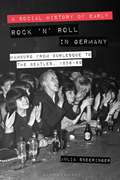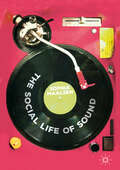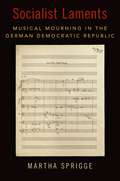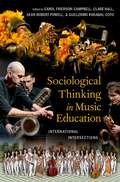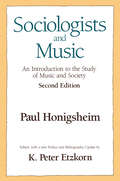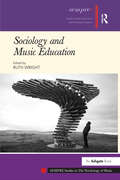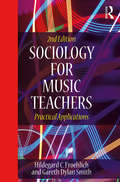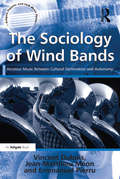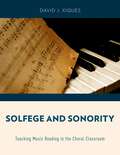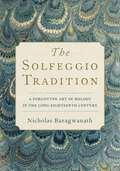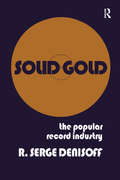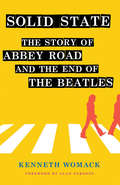- Table View
- List View
The Social and Religious Designs of J. S. Bach's Brandenburg Concertos
by Michael MarissenThis new investigation of the Brandenburg Concertos explores musical, social, and religious implications of Bach's treatment of eighteenth-century musical hierarchies. By reference to contemporary music theory, to alternate notions of the meaning of "concerto," and to various eighteenth-century conventions of form and instrumentation, the book argues that the Brandenburg Concertos are better understood not as an arbitrary collection of unrelated examples of "pure" instrumental music, but rather as a carefully compiled and meaningfully organized set. It shows how Bach's concertos challenge (as opposed to reflect) existing musical and social hierarchies. Careful consideration of Lutheran theology and Bach's documented understanding of it reveals, however, that his music should not be understood to call for progressive political action. One important message of Lutheranism, and, in this interpretation, of Bach's concertos, is that in the next world, the heavenly one, the hierarchies of the present world will no longer be necessary. Bach's music more likely instructs its listeners how to think about and spiritually cope with contemporary hierarchies than how to act upon them. In this sense, contrary to currently accepted views, Bach's concertos share with his extensive output of vocal music for the Lutheran liturgy an essentially religious character.
The Social and Religious Designs of J. S. Bach's Brandenburg Concertos
by Michael MarissenThis new investigation of the Brandenburg Concertos explores musical, social, and religious implications of Bach's treatment of eighteenth-century musical hierarchies. By reference to contemporary music theory, to alternate notions of the meaning of "concerto," and to various eighteenth-century conventions of form and instrumentation, the book argues that the Brandenburg Concertos are better understood not as an arbitrary collection of unrelated examples of "pure" instrumental music, but rather as a carefully compiled and meaningfully organized set. It shows how Bach's concertos challenge (as opposed to reflect) existing musical and social hierarchies. Careful consideration of Lutheran theology and Bach's documented understanding of it reveals, however, that his music should not be understood to call for progressive political action. One important message of Lutheranism, and, in this interpretation, of Bach's concertos, is that in the next world, the heavenly one, the hierarchies of the present world will no longer be necessary. Bach's music more likely instructs its listeners how to think about and spiritually cope with contemporary hierarchies than how to act upon them. In this sense, contrary to currently accepted views, Bach's concertos share with his extensive output of vocal music for the Lutheran liturgy an essentially religious character.
A Social History of Early Rock ‘n’ Roll in Germany: Hamburg from Burlesque to The Beatles, 1956-69
by Julia SneeringerA Social History of Early Rock 'n' Roll in Germany explores the people and spaces of St. Pauli's rock'n'roll scene in the 1960s. Starting in 1960, young British rockers were hired to entertain tourists in Hamburg's red-light district around the Reeperbahn in the area of St. Pauli. German youths quickly joined in to experience the forbidden thrill of rock'n'roll, and used African American sounds to distance themselves from the old Nazi generation. In 1962 the Star Club opened and drew international attention for hosting some of the Beatles' most influential performances. In this book, Julia Sneeringer weaves together this story of youth culture with histories of sex and gender, popular culture, media, and subculture. By exploring the history of one locale in depth, Sneeringer offers a welcome contribution to the scholarly literature on space, place, sound and the city, and pays overdue attention to the impact that Hamburg had upon music and style. She is also careful to place performers such as The Beatles back into the social, spatial, and musical contexts that shaped them and their generation. This book reveals that transnational encounters between musicians, fans, entrepreneurs and businessmen in St. Pauli produced a musical style that provided emotional and physical liberation and challenged powerful forces of conservatism and conformity with effects that transformed the world for decades to come.
A Social History of Early Rock ‘n’ Roll in Germany: Hamburg from Burlesque to The Beatles, 1956-69
by Julia SneeringerA Social History of Early Rock 'n' Roll in Germany explores the people and spaces of St. Pauli's rock'n'roll scene in the 1960s. Starting in 1960, young British rockers were hired to entertain tourists in Hamburg's red-light district around the Reeperbahn in the area of St. Pauli. German youths quickly joined in to experience the forbidden thrill of rock'n'roll, and used African American sounds to distance themselves from the old Nazi generation. In 1962 the Star Club opened and drew international attention for hosting some of the Beatles' most influential performances. In this book, Julia Sneeringer weaves together this story of youth culture with histories of sex and gender, popular culture, media, and subculture. By exploring the history of one locale in depth, Sneeringer offers a welcome contribution to the scholarly literature on space, place, sound and the city, and pays overdue attention to the impact that Hamburg had upon music and style. She is also careful to place performers such as The Beatles back into the social, spatial, and musical contexts that shaped them and their generation. This book reveals that transnational encounters between musicians, fans, entrepreneurs and businessmen in St. Pauli produced a musical style that provided emotional and physical liberation and challenged powerful forces of conservatism and conformity with effects that transformed the world for decades to come.
The Social Life of Sound
by Sophia MaalsenThe Social Life of Sounds argues for the agency of sounds and music and the acceleration of their social lives in the Digital Age. Drawing upon research with composers, producers, record collectors, DJs and record labels, the book problematises the notion of artistic authorship as it is framed in Western systems of property. Acknowledging that ‘things’ – sounds, samples, and recorded music – and people are co-constituted and that personhood is distributed through things and their reuse, Maalsen makes a case for understanding sound as multibiographical and challenges the possessive individual that is the basis of artistic copyright.
Socialist Laments: Musical Mourning in the German Democratic Republic (New Cultural History of Music)
by Martha SpriggeAntifascist and socialist monuments pervaded the landscape of the former German Democratic Republic (1949-89), presenting a distorted vision of the national past. Official commemorative culture in East Germany celebrated a selective set of political heroes, seeming to leave no public space for mourning those who were excluded from the country's founding myths. Socialist Laments: Musical Mourning in the German Democratic Republic examines the role of music in this nation's memorial culture, demonstrating how music facilitated the expressions of loss within spaces of commemoration for East German citizens. Music performed during state-sponsored memorial rituals no doubt bolstered official narratives of the German past. But it simultaneously provided an outlet for mourning in highly politicized environment. The book presents both a history and theory of musical mourning in East Germany. Using a site-specific approach to analysis, author Martha Sprigge demonstrates how the multiple semantic networks opened up by these musical works facilitated many memorial associations without necessitating the overt articulation of a mourned subject. Throughout the country's forty-year existence, music offered East German citizens an audible outlet for working through traumatic losses-both collective and individual-that was distinct from other artistic expressive possibilities. The book reveals the ways that East Germany's extensive commemorative repertoire helped composers, performers, and audiences navigate between the inevitable need to mourn on the one hand, and the seeming impossibilities of mourning on the other.
Socialist Laments: Musical Mourning in the German Democratic Republic (New Cultural History of Music)
by Martha SpriggeAntifascist and socialist monuments pervaded the landscape of the former German Democratic Republic (1949-89), presenting a distorted vision of the national past. Official commemorative culture in East Germany celebrated a selective set of political heroes, seeming to leave no public space for mourning those who were excluded from the country's founding myths. Socialist Laments: Musical Mourning in the German Democratic Republic examines the role of music in this nation's memorial culture, demonstrating how music facilitated the expressions of loss within spaces of commemoration for East German citizens. Music performed during state-sponsored memorial rituals no doubt bolstered official narratives of the German past. But it simultaneously provided an outlet for mourning in highly politicized environment. The book presents both a history and theory of musical mourning in East Germany. Using a site-specific approach to analysis, author Martha Sprigge demonstrates how the multiple semantic networks opened up by these musical works facilitated many memorial associations without necessitating the overt articulation of a mourned subject. Throughout the country's forty-year existence, music offered East German citizens an audible outlet for working through traumatic losses-both collective and individual-that was distinct from other artistic expressive possibilities. The book reveals the ways that East Germany's extensive commemorative repertoire helped composers, performers, and audiences navigate between the inevitable need to mourn on the one hand, and the seeming impossibilities of mourning on the other.
Sociological Thinking in Music Education: International Intersections
by Carol Frierson-Campbell, Clare Hall, Sean Robert Powell, Guillermo Rosabal-CotoSociological Thinking in Music Education presents new ideas about music teaching and learning as important social, political, economic, ecological, and cultural ways of being. At the book's heart is the intersection between theory and practice where readers gain glimpses of intriguing social phenomena as lived through music learning and teaching. The vital roles played by music and music education in various societies around the world are illustrated through pivotal intersections between music education and sociology: community, schooling, and issues of decolonization. In this book, emerging as well as established scholars mobilize the links between applied sociology, music, education, and music education in ways that intersect the scholarly and the personal. These interdisciplinary vantage points fulfil the book's overarching aim to move beyond mere descriptions of what is, by analyzing how social inequalities and inequities, conflict and control, and power can be understood in and through music teaching and learning at both individual and collective levels. The result is not only encountering new ideas regarding the social construction of music education practices in specific places, but also seeing and hearing familiar ones in fresh ways. Digital assets enable readers to meet the authors and the points of their inquiry via various audiovisual media, including videos, a documentary music film, and multi-lingual video précis for each chapter in English as well as in each author's language of origin.
Sociological Thinking in Music Education: International Intersections
Sociological Thinking in Music Education presents new ideas about music teaching and learning as important social, political, economic, ecological, and cultural ways of being. At the book's heart is the intersection between theory and practice where readers gain glimpses of intriguing social phenomena as lived through music learning and teaching. The vital roles played by music and music education in various societies around the world are illustrated through pivotal intersections between music education and sociology: community, schooling, and issues of decolonization. In this book, emerging as well as established scholars mobilize the links between applied sociology, music, education, and music education in ways that intersect the scholarly and the personal. These interdisciplinary vantage points fulfil the book's overarching aim to move beyond mere descriptions of what is, by analyzing how social inequalities and inequities, conflict and control, and power can be understood in and through music teaching and learning at both individual and collective levels. The result is not only encountering new ideas regarding the social construction of music education practices in specific places, but also seeing and hearing familiar ones in fresh ways. Digital assets enable readers to meet the authors and the points of their inquiry via various audiovisual media, including videos, a documentary music film, and multi-lingual video précis for each chapter in English as well as in each author's language of origin.
Sociologists and Music
by Paul HonigsheimSociologists have always been fascinated with music. In one way or another they have encountered music as an important social force in its own right, as an accompaniment or byproduct of phenomena they studied (such as youth culture or the drug scene), or as a means for obtaining social compliance (as in religious ceremonies or in the military). This book goes one step toward remedying this situation by culling the existing literature for building blocks toward introducing sociological synthesis and by presenting the English version of the extensive writings on music and society by Paul Honigsheim.
Sociologists and Music
by Paul HonigsheimSociologists have always been fascinated with music. In one way or another they have encountered music as an important social force in its own right, as an accompaniment or byproduct of phenomena they studied (such as youth culture or the drug scene), or as a means for obtaining social compliance (as in religious ceremonies or in the military). This book goes one step toward remedying this situation by culling the existing literature for building blocks toward introducing sociological synthesis and by presenting the English version of the extensive writings on music and society by Paul Honigsheim.
Sociology and Music Education
by Ruth WrightSociology and Music Education addresses a pressing need to provide a sociological foundation for understanding music education. The music education community, academic and professional, has become increasingly aware of the need to locate the issues facing music educators within a broader sociological context. This is required both as a means to deeper understanding of the issues themselves and as a means to raising professional consciousness of the macro issues of power and politics by which education is often constrained. The book outlines some introductory concepts in sociology and music education and then draws together seminal theoretical insights with examples from practice with innovative applications of sociological theory to the field of music education. The editor has taken great care to select an international community of experienced researchers and practitioners as contributors who reflect current trends in the sociology of music education in Europe and the UK. The book concludes with an Afterword by Christopher Small.
Sociology and Music Education
by Ruth WrightSociology and Music Education addresses a pressing need to provide a sociological foundation for understanding music education. The music education community, academic and professional, has become increasingly aware of the need to locate the issues facing music educators within a broader sociological context. This is required both as a means to deeper understanding of the issues themselves and as a means to raising professional consciousness of the macro issues of power and politics by which education is often constrained. The book outlines some introductory concepts in sociology and music education and then draws together seminal theoretical insights with examples from practice with innovative applications of sociological theory to the field of music education. The editor has taken great care to select an international community of experienced researchers and practitioners as contributors who reflect current trends in the sociology of music education in Europe and the UK. The book concludes with an Afterword by Christopher Small.
Sociology for Music Teachers: Practical Applications
by Gareth Dylan Smith Hildegard FroehlichSociology for Music Teachers: Practical Applications, Second Edition, outlines the basic concepts relevant to understanding music teaching and learning from a sociological perspective. It demonstrates the relationship of music to education, schooling and society, and examines the consequences for making instructional choices in teaching methods and repertoire selection. The authors look at major theories, and concepts relevant to music education, texts in the sociology of music, and thoughts of selected ethnomusicologists and sociologists. The new edition takes a more global approach than was the case in the first edition and includes the application of sociological theory to contexts beyond the classroom. The Second Edition: Presents major theories in ethnomusicology, both traditional and contemporary. Takes a global approach by presenting a variety of teaching practices beyond those found in the United States. Emphasizes music education in a traditional classroom setting, but also applies specific constructs to studio teaching situations in conservatories (with private lessons) and community music. Provides recommendations for teaching practices by addressing popular music in school music curricula, suggests inclusionary projects that explore musical styles and repertoire of the past and present, and connects school to community music practices of varying kinds. Contains an increased number of suggestions for projects and discussions among the students using the book.
Sociology for Music Teachers: Practical Applications
by Gareth Dylan Smith Hildegard FroehlichSociology for Music Teachers: Practical Applications, Second Edition, outlines the basic concepts relevant to understanding music teaching and learning from a sociological perspective. It demonstrates the relationship of music to education, schooling and society, and examines the consequences for making instructional choices in teaching methods and repertoire selection. The authors look at major theories, and concepts relevant to music education, texts in the sociology of music, and thoughts of selected ethnomusicologists and sociologists. The new edition takes a more global approach than was the case in the first edition and includes the application of sociological theory to contexts beyond the classroom. The Second Edition: Presents major theories in ethnomusicology, both traditional and contemporary. Takes a global approach by presenting a variety of teaching practices beyond those found in the United States. Emphasizes music education in a traditional classroom setting, but also applies specific constructs to studio teaching situations in conservatories (with private lessons) and community music. Provides recommendations for teaching practices by addressing popular music in school music curricula, suggests inclusionary projects that explore musical styles and repertoire of the past and present, and connects school to community music practices of varying kinds. Contains an increased number of suggestions for projects and discussions among the students using the book.
The Sociology of Wind Bands: Amateur Music Between Cultural Domination and Autonomy (Ashgate Popular and Folk Music Series)
by Vincent Dubois Jean-Matthieu Méon translated by BartDespite the musical and social roles they play in many parts of the world, wind bands have not attracted much interest from sociologists. The Sociology of Wind Bands seeks to fill this gap in research by providing a sociological account of this musical universe as it stands now. Based on a qualitative and quantitative survey conducted in northeastern France, the authors present a vivid description of the orchestras, the backgrounds and practices of their musicians, and the repertoires they play. Their multi-level analysis, ranging from the cultural field to the wind music subfield and to everyday life relationships within bands and local communities, sheds new light on the social organisation, meanings and functions of a type of music that is all too often taken for granted. Yet they go further than merely portraying a musical genre. As wind music is routinely neglected and socially defined in terms of its poor musical quality or even bad taste, the book addresses the thorny issue of the effects of cultural hierarchy and domination. It proposes an imaginative and balanced framework which, beyond the specific case of wind music, is an innovative contribution to the sociology of lowbrow culture.
The Sociology of Wind Bands: Amateur Music Between Cultural Domination and Autonomy (Ashgate Popular and Folk Music Series)
by Vincent Dubois Jean-Matthieu Méon translated by BartDespite the musical and social roles they play in many parts of the world, wind bands have not attracted much interest from sociologists. The Sociology of Wind Bands seeks to fill this gap in research by providing a sociological account of this musical universe as it stands now. Based on a qualitative and quantitative survey conducted in northeastern France, the authors present a vivid description of the orchestras, the backgrounds and practices of their musicians, and the repertoires they play. Their multi-level analysis, ranging from the cultural field to the wind music subfield and to everyday life relationships within bands and local communities, sheds new light on the social organisation, meanings and functions of a type of music that is all too often taken for granted. Yet they go further than merely portraying a musical genre. As wind music is routinely neglected and socially defined in terms of its poor musical quality or even bad taste, the book addresses the thorny issue of the effects of cultural hierarchy and domination. It proposes an imaginative and balanced framework which, beyond the specific case of wind music, is an innovative contribution to the sociology of lowbrow culture.
Soda Goes Pop: Pepsi-Cola Advertising and Popular Music (Tracking Pop)
by Joanna LoveFrom its 1939 “Nickel, Nickel” jingle to pathbreaking collaborations with Michael Jackson and Madonna to its pair of X Factor commercials in 2011 and 2012, Pepsi-Cola has played a leading role in drawing the American pop music industry into a synergetic relationship with advertising. This idea has been copied successfully by countless other brands over the years, and such commercial collaboration is commonplace today—but how did we get here? How and why have pop music aesthetics been co-opted to benefit corporate branding? What effect have Pepsi’s music marketing practices in particular had on other brands, the advertising industry, and popular music itself? Soda Goes Pop investigates these and other vital questions around the evolving relationships between popular music and corporate advertising. Joanna K. Love joins musical analysis, historical research, and cultural theory to trace parallel shifts in these industries over eight decades. In addition to scholarly and industry resources, she draws on first-hand accounts, pop culture magazines, trade press journals, and other archival materials. Pepsi’s longevity as an influential American brand, its legendary commercials, and its pioneering, relentless pursuit of alliances with American musical stars makes the brand a particularly instructive point of focus. Several of the company’s most famous ad campaigns are prime examples of the practice of redaction, whereby marketers select, censor, and restructure musical texts to fit commercial contexts in ways that revise their aesthetic meanings and serve corporate aims. Ultimately, Love demonstrates how Pepsi’s marketing has historically appropriated and altered images of pop icons and the meanings of hit songs, and how these commercials shaped relationships between the American music business, the advertising industry, and corporate brands. Soda Goes Pop is a rich resource for scholars and students of American studies, popular culture, advertising, broadcast media, and musicology. It is also an accessible and informative book for the general reader, as Love’s musical and theoretical analyses are clearly presented for non-specialist audiences and readers with varying degrees of musical knowledge.
Solfege and Sonority: Teaching Music Reading in the Choral Classroom
by David J. XiquesSolfege and Sonority is a guide for teaching music literacy in a choral rehearsal, with a focus on the needs of teachers who work with young singers. The book lays out teaching sequences for melodic and rhythmic concepts, lesson plans, and concise strategies for introducing key techniques. The individual lessons themselves are short (no more than 4-6 minutes each) and comprehensive, encouraging singers to develop a literacy of rhythm and melody together. In 18 easy-to-use lessons for teachers and conductors and tying the lessons to the teacher's current repertoire, longtime choral director and teacher David J. Xiques has created a practical and viable solution to the challenges of many conductors, as well as providing a much-needed manual for upper-level choral pedagogy courses. The comprehensive companion website provides access to videos of exercises, worksheets, and teaching materials.
Solfege and Sonority: Teaching Music Reading in the Choral Classroom
by David J. XiquesSolfege and Sonority is a guide for teaching music literacy in a choral rehearsal, with a focus on the needs of teachers who work with young singers. The book lays out teaching sequences for melodic and rhythmic concepts, lesson plans, and concise strategies for introducing key techniques. The individual lessons themselves are short (no more than 4-6 minutes each) and comprehensive, encouraging singers to develop a literacy of rhythm and melody together. In 18 easy-to-use lessons for teachers and conductors and tying the lessons to the teacher's current repertoire, longtime choral director and teacher David J. Xiques has created a practical and viable solution to the challenges of many conductors, as well as providing a much-needed manual for upper-level choral pedagogy courses. The comprehensive companion website provides access to videos of exercises, worksheets, and teaching materials.
The Solfeggio Tradition: A Forgotten Art of Melody in the Long Eighteenth Century
by Nicholas BaragwanathHow did castrati manage to amaze their eighteenth-century audiences by singing the same aria several times in completely different ways? And how could composers of the time write operas in a matter of days? The secret lies in the solfeggio tradition, a music education method that was fundamental to the training of European musicians between 1680 and 1830 a time during which professional musicians belonged to the working class. As disadvantaged children in orphanages learned the musical craft through solfeggio lessons, many were lifted from poverty, and the most successful were propelled to extraordinary heights of fame and fortune. In this first book on the solfeggio tradition, author Nicholas Baragwanath draws on over a thousand manuscript sources to reconstruct how professionals became skilled performers and composers who could invent and modify melodies at will. By introducing some of the simplest exercises in scales, leaps, and cadences that apprentices would have encountered, this book allows readers to retrace the steps of solfeggio training and learn to generate melody by 'speaking' it like an eighteenth-century musician. As it takes readers on a fascinating journey through the fundamentals of music education in the eighteenth century, this book uncovers a forgotten art of melody that revolutionizes our understanding of the history of music pedagogy.
The Solfeggio Tradition: A Forgotten Art of Melody in the Long Eighteenth Century
by Nicholas BaragwanathHow did castrati manage to amaze their eighteenth-century audiences by singing the same aria several times in completely different ways? And how could composers of the time write operas in a matter of days? The secret lies in the solfeggio tradition, a music education method that was fundamental to the training of European musicians between 1680 and 1830 a time during which professional musicians belonged to the working class. As disadvantaged children in orphanages learned the musical craft through solfeggio lessons, many were lifted from poverty, and the most successful were propelled to extraordinary heights of fame and fortune. In this first book on the solfeggio tradition, author Nicholas Baragwanath draws on over a thousand manuscript sources to reconstruct how professionals became skilled performers and composers who could invent and modify melodies at will. By introducing some of the simplest exercises in scales, leaps, and cadences that apprentices would have encountered, this book allows readers to retrace the steps of solfeggio training and learn to generate melody by 'speaking' it like an eighteenth-century musician. As it takes readers on a fascinating journey through the fundamentals of music education in the eighteenth century, this book uncovers a forgotten art of melody that revolutionizes our understanding of the history of music pedagogy.
Solid Gold: Popular Record Industry
by R. Serge DenisoffMore than 90 record companies release over 9,000 pop records each year-a staggering total of 52,000 songs. Each one competes for the gold record, the recording industry's symbol of success that certifies $1 million worth of records have been sold. Solid Gold explains why, for each record that succeeds, countless others fail. This book follows the progress of a record through production, marketing, and distribution, and shows how a mistake made at any point can mean its doom. Denisoff suggests that a drastic shift in the demographic makeup of the pop music audience during the sixties has resulted in a broader listening public, including fans at every level of society.
Solid Gold: Popular Record Industry
by R. Serge DenisoffMore than 90 record companies release over 9,000 pop records each year-a staggering total of 52,000 songs. Each one competes for the gold record, the recording industry's symbol of success that certifies $1 million worth of records have been sold. Solid Gold explains why, for each record that succeeds, countless others fail. This book follows the progress of a record through production, marketing, and distribution, and shows how a mistake made at any point can mean its doom. Denisoff suggests that a drastic shift in the demographic makeup of the pop music audience during the sixties has resulted in a broader listening public, including fans at every level of society.
Solid State: The Story of "Abbey Road" and the End of the Beatles
by Kenneth WomackAcclaimed Beatles historian Kenneth Womack offers the most definitive account yet of the writing, recording, mixing, and reception of Abbey Road.In February 1969, the Beatles began working on what became their final album together. Abbey Road introduced a number of new techniques and technologies to the Beatles' sound, and included "Come Together," "Something," and "Here Comes the Sun," which all emerged as classics. Womack's colorful retelling of how this landmark album was written and recorded is a treat for fans of the Beatles. Solid State takes readers back to 1969 and into EMI's Abbey Road Studio, which boasted an advanced solid state transistor mixing desk. Womack focuses on the dynamics between John, Paul, George, Ringo, and producer George Martin and his team of engineers, who set aside (for the most part) the tensions and conflicts that had arisen on previous albums to create a work with an innovative (and, among some fans and critics, controversial) studio-bound sound that prominently included the new Moog synthesizer, among other novelties. As Womack shows, Abbey Road was the culmination of the instrumental skills, recording equipment, and artistic vision that the band and George Martin had developed since their early days in the same studio seven years earlier. A testament to the group's creativity and their producer's ingenuity, Solid State is required reading for all fans of the Beatles and the history of rock 'n' roll.

